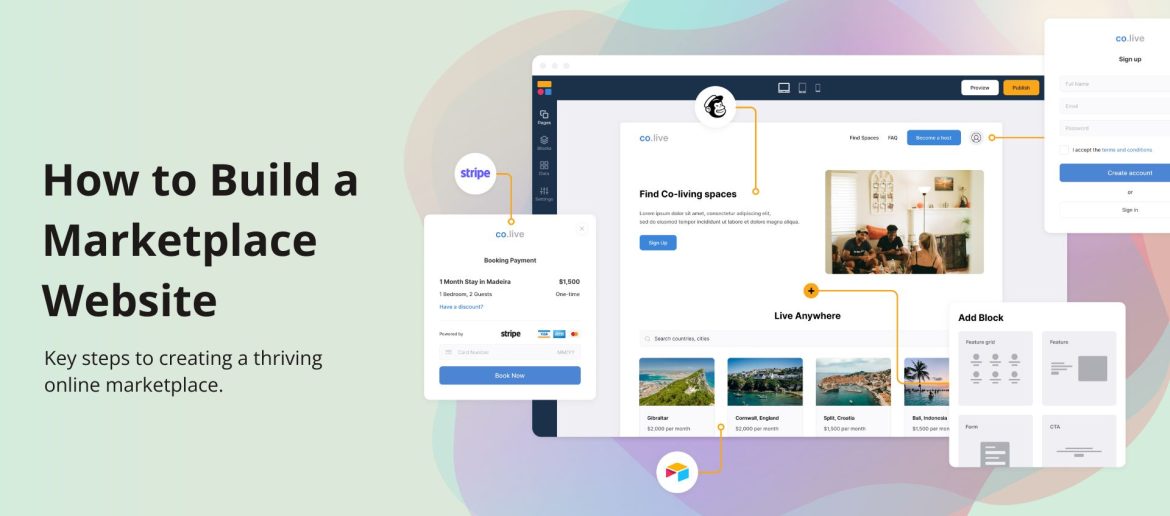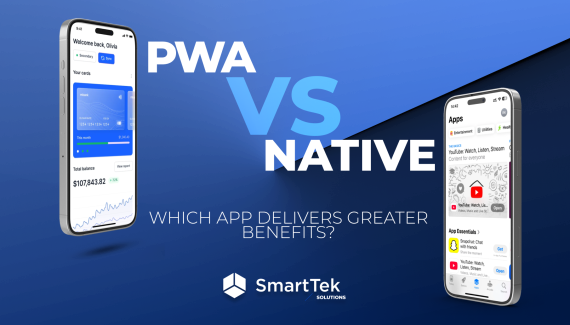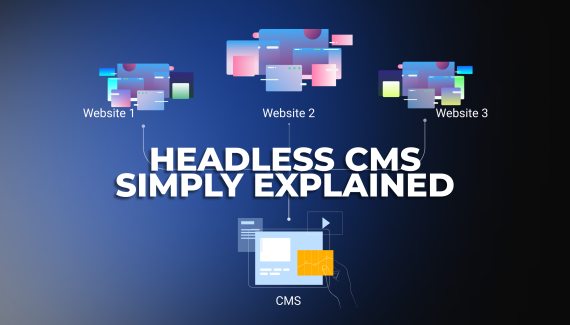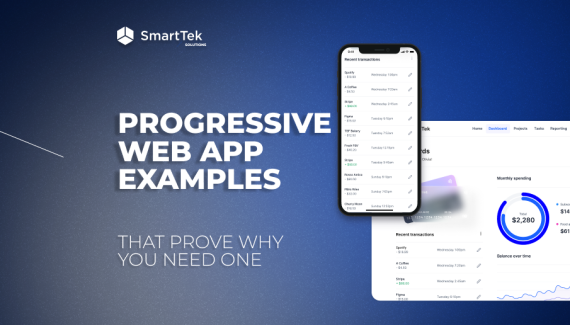A marketplace website is an online platform that allows different sellers to offer their products or services. This kind of platform actually links sellers and buyers.
We can call marketplaces the next stage of development of large e-commerce projects as many leading online stores often switch to an operating model that aggregates offers from other sellers on their platform, aiming at expanding the product range and increasing their market reach. Platforms like eBay, AliExpress, Etsy, and others are among the world-famous websites of this type.
We can subdivide them: by the type of participants (B2B, B2C, and C2C), products, services, or monetization. However, any marketplace has its main purpose — to simplify the interaction between vendors and customers, and to help them find each other.
Let’s look at the main points to consider when creating this type of project, starting with searching for the idea and finishing with initiating development.
Types of Online Marketplaces
Marketplaces can be classified into several main types according to particular features. Let us take a quick look at each of the types, classification by participants:
- B2C (Business to Consumer)
- B2B (Business to Business)
- C2C (Customer to Customer)
You can also find C2B (customer to business) types of marketplaces. Those, for example, are online marketplaces where private experts offer their professional services to different companies.
The above-mentioned classification is the most common in the industry. However, you can also distinguish online marketplaces according to the types of products presented on them:
- commodity marketplaces
- service marketplaces
- digital goods marketplaces
- data exchange platforms
- investments and crowdfunding.
How to Find Ideas for an Online Marketplace
Everything starts with an idea. So, before you start planning future functionality of your startup, choosing a technology stack and finding the optimal business model, you will have to analyze the potential of the chosen niche.
In a broad sense, all potential niches may already be occupied, but some narrower segments are still very promising. For example, it is clear that the plan of creating a marketplace to sell digital equipment and electronics will not currently work. On the other hand, a niche photography aggregator marketplace is quite a viable idea.
Here are several recommendations that will help you arrive at a good idea for a marketplace website:
- Analyze niches, moving from general segments to narrower ones.
- Make sure you estimate the market volume, especially if you want to target a specific country or region.
- Make sure you solve a real problem, not a fictional one, and people are ready to pay for the products/services offered.
- Confirm your idea is viable by interviewing representatives from the the target audience and ordering a search demand analysis from marketing specialists.
- Analyze competitors and make sure you can offer more value to your target audience than other niche players.
Lastly, remember one more interesting rule:
Not every successful startup starts with a brilliant idea. To be successful, it is sometimes enough to adapt an existing idea to the needs of a specific market.
Now is the time for niche markets. In a narrow segment, even a small startup can successfully compete with large corporations.
In the future, niche marketplaces will win against multipurpose platforms. Large markets are now occupied. Therefore, the founder’s task is to find a promising narrow market segment with no competition from large players.
Find the Right Business Model
For visitors, a marketplace is just a showcase displaying products, but, actually, a marketplace is a platform with elaborate business logic and processes. Moreover, you have to comprehend from the very beginning that such a project should generate profit. To achieve this, you will need to choose an elaborate business model with particular care.
There are several proven basic monetization options to use:
- Commission from operations. This is one of the most popular business models for online marketplaces. Users can take advantage of it as they do not pay any fees to the marketplace until they start getting real customers and profits. The website receives benefits from such cooperation as well since it charges a percentage of the total amount of the money passing through it. Examples: Etsy.com, Fiverr.com.
- Monthly subscription. Users pay for a certain period when they use a trading platform. Its cost, customer engagement and retention issues are the weak points of this business model.
- Freemium. Sellers on the marketplace pay for additional features, such as a private message function or to place an additional range of goods (extended list of services).
- Ad promotion. Sellers use the platform for free and only pay to make their ads or product pages more visible. For example, sellers can pay to get their offers on the main page or at the top of the main list.
- Ad placement fee. A business model like this is similar to the way how display advertising works — the marketplace provides sellers with access to the audience. For instance, sellers can sign up to a website for free and are only charged for placing ads selling their goods or services.
- Lead commission. Customers leave their queries on the website, sellers can respond to them, and the platform charges a commission fee for the services provided. Sellers benefit from this model because they only pay for contacting their potential customers. Mainly b2b or b2c segments resort to this monetization method.
Some startups combine several business models at once while searching for the most advantageous combination of monetization options.
Top Features to Include in a Marketplace Website Development
You have to make the decision to implement a particular function based on how a particular capability can help your target audience solve their problems. Here are the main features relevant to a marketplace platform:
- Authorization and registration. This usually means a standard authorization procedure, using email and password, which can be expanded to authorization via social networks, or two-factor authorization via SMS or other sources.
- Profiles (vendor and buyer). Vendors will have the ability to create a business page and add or edit product/service pages.
- Administration module. View and manage all data in the system, view transactions, resolve disputes, and get analytics and statistics.
- Internal search. Search by fields, and filter and sort out data.
- Product card. A product or service page with fields to fill out data.
- Recommended products. Based on user activity and purchases, similar offers are shown to customers.
- Notifications. Inform users about important actions (orders and their processing, comments, etc.).
- Shopping cart. Easy check-out for add to shopping cart and manage orders.
- Payment Gateway. Link bank cards and integrate payment systems, view and manage transactions, payment history, or cancel payments.
- Feedback system. It also includes the ability to rate products.
- Favorites (wish list). Provide users with the ability to save their favorite products to bookmarks to buy them later.
We have listed the main marketplace website features, but this list can be expanded, depending on the type of project and the niche in which the marketplace platform operates.
Choose the Technology Stack
Create such a website based on “boxed” solutions or order custom development. Wanting to save money, customers often choose boxed solutions at the initial development stages. This is quite logical if you do not have enough money or time, or you just want to test an idea.
However, boxed solutions have limited flexibility, and customizing a boxed version is sometimes more expensive and takes much longer than building a marketplace website with similar functions from scratch.
That is why we recommend you simply find an experienced team of developers who will select the best solution and technology/tool stack for you and take on all the complex technical issues.
Build a Marketplace Website MVP
A startup in this niche can turn out to be an expensive project that will take a long time. Therefore, it is better to start with an MVP. This option will provide you with the opportunity to test your product with minimal functionality and financial investment in real market conditions.
When developing a marketplace, the main advice is to avoid trying to implement all the functions in the first product version. If you try to do everything at once, you will face several problems:
- It will be more difficult for you to bring the whole idea to the development team, and the technical specifications manual may become huge with dozens or even hundreds of pages.
- Project development will be a long process, and that creates risks of getting a low-quality product as a result.
- At some point, you may run out of budget, and you will have to halt the project.
- Finally, while implementing the project, you will have additional demands for it, which will be entered into the technical specifications, making it larger and larger. And, in the end, no one will remember which version is the final one.
In general, if you do not want your project development to take too long, be too expensive, and cause too much pain, split the implementation into several versions, gain customers, and track their reaction to new features implemented on the website.
How Much Does It Cost to Make a Marketplace?
Besides ready-made CMS (Magento, CS-Cart, WordPress), you can use various frameworks to build a marketplace. This approach saves time and money when compared to custom design. At the same time, custom marketplace development provides a lot more flexibility than ready-made solutions.
Moreover, you will face such small but regular cost-consuming items as hosting, various ready-made technical solutions (modules), and paid third-party services (via API).
It is important to realize that many factors affect the price, and therefore, everything is very individual here. For instance, in case you also plan to develop a mobile marketplace app apart from a website, it will increase your project budget accordingly.
You can calculate everything using a simple formula:
Developers’ hourly rates * the number of work hours
Consequently, you may find it profitable to outsource your marketplace development since programmer average hourly rates are lower in other countries. This fact will allow you to obtain good results at a relatively low cost.
How to start a marketplace website from scratch
Well, now, after we have covered all the key points, let us make a brief list of steps you have to take to make an online marketplace from scratch:
- Find a good idea and test its viability. We recommend you launch a niche marketplace but not another Amazon. This approach will provide you with a better chance of success.
- Choose a business model. In modern circumstances, the technical part plays a lesser role than monetization. You may find it easy to create a marketplace. However, developing it into a sustainable business is quite a different task level.
- Make a suggested list of planned features. After that, find a good technology team to help you draw up a detailed SRS document and plan the work.
- Start an MVP. Never delay entering the market but check the idea in real-world scenarios.
- Find your first sellers and buyers. Using their help, you can quickly get the feedback you need.
- Launch an online marketplace and start promoting it. Learn inexpensive marketing tactics for startups.
If you make sure your idea is promising and people are willing to pay for it, you can focus on increasing your audience and further project development.
Want to set up your marketplace right away?
Start by choosing a reliable software development team which will not just provide marketplace website development services, but become a fully fledged partner available for you at all stages from consultation to launching the project.
Write to us, and we will help you create a really high-quality product!






 view the post
view the post
 view the post
view the post
 view the post
view the post

